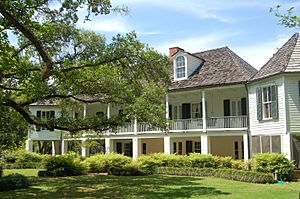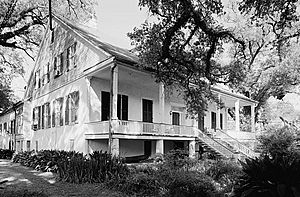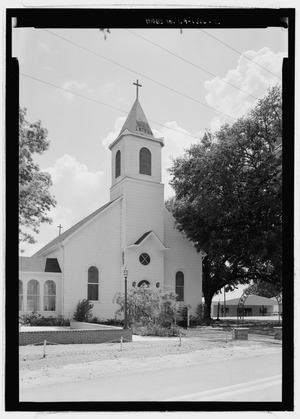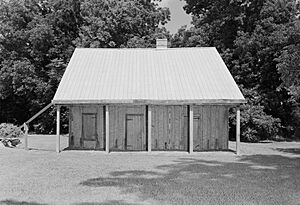Isle Brevelle facts for kids
Quick facts for kids
Isle Brevelle
|
|
|---|---|
|
Community
|
|

|
|
| Country | United States |
| State | Louisiana |
| Parish | Natchitoches Parish |
| Named for | Jean Baptiste Brevelle II |
| Time zone | UTC-6 (Central (CST)) |
| • Summer (DST) | UTC-5 (CDT) |
Isle Brevelle is a special place in Natchitoches Parish, Louisiana. It is a community with a rich mix of cultures. This area started as a home for Native American and Louisiana Creole families. For many years, people called it Côte Joyeuse, which means Joyous Coast in English.
Isle Brevelle is known as the birthplace of Creole culture. It is still a center for Creole art and stories. Here, European (mostly French and Spanish), African, and Native American cultures blend together. You can find the Cane River Creole National Historical Park here. It is also part of the Louisiana African American Heritage Trail.
Contents
Discovering Isle Brevelle's Location
Isle Brevelle is in Natchitoches Parish, Louisiana. It covers about 18,000 acres of land. This land lies between the Cane River and Bayou Brevelle. Two main roads, LA 119 and LA 484, run through the area.
The "island" is a long, narrow strip of land. It is about thirty miles long and three to four miles wide. It is south of Natchitoches, Louisiana. Rivers and bayous like the Cane River, Red River, Old River (Natchitoches Parish), and Bayou Brevelle surround it. Bayou Brevelle is named after Jean Baptiste Brevel. Long ago, people called Isle Brevelle "the richest cotton-growing part of the south." A priest from France, Father Yves-Marie LeConiniat, even called it an "earthly paradise."
Isle Brevelle is a key stop on the Louisiana African American Heritage Trail. It has over 60 important cultural, religious, and historical sites. These include St. Augustine Parish Church and Melrose Plantation. You can also find burial sites of Louisiana Creole people and Native Americans. These Native Americans include the Adai, Natchitoches, and Hasinai tribes. The Cane River National Historical Area has a special "Isle Brevelle Trail." This trail shows off the "birthplace of Creole culture."
The History of Isle Brevelle
The Creole community here comes from many backgrounds. They are descendants of French and Spanish settlers, Africans, Anglo-Americans, and Native Americans. The Native American groups were part of the Caddo Confederacy. These included the Natchitoches and Adai tribes.
Early Settlers and Family Names
Isle Brevelle is named after Jean Baptiste Brevelle II. He was an early settler and an explorer in the 1700s. He was also a soldier in the Natchitoches Militia. His father, Jean Baptiste Brevelle, was an explorer from Paris, France. His mother was Anne des Cadeaux, a Native American woman from the Adai Caddo tribe. Jean Baptiste Brevelle II was baptized on May 20, 1736. This was recorded in the oldest Catholic book in the Louisiana colony. In 1765, he was given the island by David Pain. This was for his help as a Caddo translator and explorer for the French and Spanish rulers.
When Louisiana became Spanish, the spelling of the Brevel family name changed to Brevelle. Later, when the United States took over, the records kept this new spelling. The Brevelle Plantation grew to be very large. It produced cotton, tobacco, and other goods.
Nicolas Augustin Metoyer's Contributions
Nicolas Augustin Metoyer (1768–1856) is seen as a very important person for Isle Brevelle. He was born into slavery. He became free in 1792 when he was 24. Around the same time, his mother, Marie Thérèse Coincoin, also became free. Together, their family started buying land. Eventually, they owned 6,000 acres. Isle Brevelle (which used to be the Brevelle Plantation) was at the center of this land. Nicolas Augustin Metoyer's home is no longer standing. However, the church he helped build, St. Augustine Parish, is still there today.
St. Augustine Parish Church

St. Augustine Parish Church, also known as Isle Brevelle Church, was started by Creole Nicolas Augustin Metoyer. Other important Creole families of Isle Brevelle also helped. St. Augustine is famous for being the first church in Louisiana built by and for free people of color.
Augustin's father took him to France in 1801. While there, Augustin saw how French villages were built around the church. When he came back to Isle Brevelle, he worked with other Creoles. They used their own money and land to build the first church in 1803. Augustin's brother, Louis, who started the nearby Melrose Plantation, may have designed and built the chapel. To raise money, families used to rent pews for their own use. They also donated religious items.
The church was blessed on July 19, 1829, by Father J. B. Blanc. It was named St. Augustine, after Augustin Metoyer's patron saint. At first, it was a mission church of St. Francois of Natchitoches.
On March 11, 1856, Bishop Auguste Martin made St. Augustine a parish on its own. His brother, Father Francois Martin, became its first full-time priest. With money from Creole families like Metoyer, Brevelle, and Guidry, St. Augustine grew. It helped start four other mission churches in the area.
In 1913, the Holy Ghost Fathers took over the parish. They stayed until 1990. The current church building was dedicated on February 15, 1917.
Schools and Convents
In 1856, the Daughters of the Cross nuns were asked to open a school on Isle Brevelle. It was called Saint Joseph's School. The nuns had already opened a school in Avoyelles Parish the year before. Mother Superior Hyacinthe LeConniat wrote that the Isle Brevelle Creoles were "people of leisure and many of wealth." The Bishop bought the nuns a house with sixty acres of land.
The Daughters of the Cross eventually ran five schools in Louisiana. They received a lot of help from wealthy Creole families. The Brevelle family, who owned plantations, gave money, food, and religious items. Their children and the children of their workers attended these schools. By 1859, the school had between 120 and 130 girls. More nuns came as more students enrolled. A larger school and a convent were built closer to St. Augustine Church. The school did well until 1862. Then, the Civil War caused fewer students to attend. In December 1863, the convent closed, and the nuns returned home.
Brevelle Station and Railroads
Railroads changed how goods and people traveled across the country. But the Cane River area got rail service later, after the Reconstruction era (after the Civil War). One of the first railroads in Natchitoches Parish was the Natchitoches Railroad, started in 1887. It later became part of the larger Texas and Pacific Railway.
One of the stops on this railroad line was the Brevelle Station. This line went from Natchitoches to Grand Encore. People say that Alphonse I built the wooden building for the Brevelle Station. His grandson, Alphonse II, remembered that "Grandpa Alphonse had built a place there, so they put a side track there [to] pick up cotton, or anything that had to be shipped." The station was used until it burned down in 1914. In 1915, the railway company asked to stop service to Brevelle Station.
Isle Brevelle in Books and Movies
Isle Brevelle has been featured in many books and films. These works share the unique culture and history of the area.
Books About Isle Brevelle
- Cane River (Isle Brevelle) Community and its Inhabitants 1722–1982 (1989): This book tells about the early people of Isle Brevelle. It includes the Native Americans of the Natchitoches Tribe.
- Isle of Canes (2004): This historical novel by Elizabeth Shown Mills tells the story of a Creole Louisiana family over many generations. It includes the founding of St. Augustine Church.
- Natchitoches and Louisiana’s Timeless Cane River (2002): Philip Gould's photography book shows the Creole settlement of Isle Brevelle. It celebrates the music, food, and history of this diverse community.
- The Collected Works of Ada Jack Carver (1980): This book has short stories and a play about the Cane River people and their special culture.
- Recipes from the Isle - Isle Brevelle, Louisiana Cookbook (1999): A Creole cookbook with recipes from members of St. Augustine Catholic Church.
- That Was Then: Memories of Cane River (2017): Joseph Moran's photography book about the historic Cane River settlement.
Movies Filmed in Isle Brevelle
- Cane River: The Isle Brevelle Church is shown in this 1982 historical romantic drama. The film was lost for many years but was found and released again in 2020.
- Steel Magnolias: Parts of this 1989 comedy-drama were filmed on Isle Brevelle. The wedding scene for the character Shelby was filmed at St. Augustine Church. The movie is about a group of women in a small Southern town.
- The Horse Soldiers: This 1959 adventure war western film was set during the American Civil War. Some scenes, including those of a plantation house, were filmed on Isle Brevelle.
- The Man in the Moon: This 1991 coming-of-age drama was Reese Witherspoon's first film. Parts of the movie, set in rural 1950s Louisiana, were filmed on Isle Brevelle.
- For Sale by Owner: This 2009 horror film was also filmed on Isle Brevelle.
- Clementine Hunter’s World: This 2016 documentary was filmed on Isle Brevelle. It shows life along the Cane River and features the colorful paintings of self-taught artist Clementine Hunter.
- Texas Before the Alamo: This 2018 documentary series was filmed at historical places in Mexico, Texas, and Louisiana, including Isle Brevelle.
Cemeteries and Burial Sites
Isle Brevelle has many important cemeteries and Native American burial sites. Natchitoches and Adai Native Americans are buried here. There is a cemetery near Bayou Brevelle at the old Brevelle Plantation. The St. Augustine Catholic Cemetery is also here.
Notable Places to Visit
- Badin-Roque House
- Cane River Lake
- Cherokee Plantation (Natchez, Louisiana)
- Coincoin–Prudhomme House (also called Maison de Marie Thérèse)
- Oakland Plantation (Natchitoches Parish, Louisiana)
- Magnolia Plantation (Derry, Louisiana)
- Melrose Plantation
- Bayou Brevelle
- Kate Chopin House (Cloutierville, Louisiana)
- Guy House (Natchitoches, Louisiana)
- Caspiana Plantation Store
- St. Augustine Parish (Isle Brevelle) Church
Famous People from Isle Brevelle
- Anne des Cadeaux (died 1754): A Native American woman, mother of Jean Baptiste Brevelle II. She is buried on Isle Brevelle.
- Jean Baptiste Brevelle (1698–1754): An early French explorer, trader, and soldier. He was the husband of Anne des Cadeaux.
- Jean Baptiste Brevelle II (1730–1806): An explorer, translator, and soldier.
- Robert Brevelle (born 1977): An entrepreneur and professor. He is a direct descendant of Isle Brevelle's founders, Jean Baptiste Brevelle II and Anne des Cadeaux.
- Marie Thérèse Coincoin (1742–1816): A businesswoman and landowner on Isle Brevelle.
- Kellyn LaCour-Conant: A restoration ecologist.
- Clementine Hunter (around 1887–1988): A self-taught folk artist who lived at Melrose Plantation in Isle Brevelle.
- Billie Stroud (1919–2010): A self-taught folk artist who used Isle Brevelle as a subject in her work.






